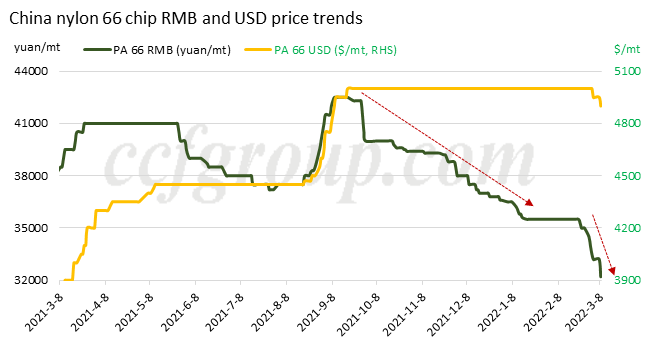Dramatic decline in nylon 66 market after accidental supply glut
In the background of a crazy increase in energy and chemical prices recently, nylon 66 polymer price decline 1,000yuan/mt, a decline of 3%, in just one day on March 8 2022. The market has stopped falling temporarily during March 4-7 on the back of rushed crude oil prices. This abrupt retrograde in nylon 66 polymer market is due to an accidental supply glut.
According to insiders, a Chinese trader has imported a large number of adiponitrile and entrusted some major manufacturers to produce nylon 66 polymer and sold to the market at a much lower rate. The supply and demand balance was suddenly broken, dragging prices down significantly.
To trace the extensive decline in nylon 66 industrial chain since the third quarter in 2021, we could find four important nodes.
1. Since Sep 2021, nylon 66 market started to fall continuously after Invista and Shenma lifted their feedstock production, and Xinli and Huafon launched new polymer capacities.
2. The decline extended after 2022 Spring Festival, as major downstream sectors, modified plastic and cord fabric, lingered weak.
3. Downtrend temporarily ceased during Mar 4-7, due to the sharp increase in crude oil and other chemical markets.
4. Prices dropped freely on Mar 8 again due to accidental supply glut.

| Nylon 66 polymer price (yuan/mt) | Decline | Decline rate | |
| 2021-9-18 | 42,500 | ||
| 2022-1-17 | 35,500 | 7,000 | 16% |
| 2022-3-4 | 33,200 | 2,300 | 6% |
| 2022-3-7 | 32,200 | 1,000 | 3% |
Beginning from mid-September 2021, nylon 66 market has entered into in a continuous decline. In September 2021, the supply tension of nylon 66 polymer eased, as both Invista and Shenma restarted the HMDA and polymer supply. Furthermore, Xinli has commenced a 20kt/year new plant in Wenzhou, Zhejiang, and Huafon has started up its 40kt/year plant in Chongqing in November and yielded products to the spot. The prices of the new materials had been much lower than the mainstream level, and hit the nylon 66 polymer market greatly. In contrast to longer supply, demand sectors had been relatively weak. Low production of automobile and other related sectors pressured on modified plastic market. During September 18 2021 to January 17 2022, the prevailing prices of nylon 66 polymer in China had dropped by 7,000yuan/mt from 4,2500yuan/mt to 35,500yuan/mt, a decline of 16%, marking that nylon 66 polymer prices have fallen from the level above 40,000yuan/mt to 30,000yuan/mt.
After the Spring Festival in 2022, nylon 66 market lingered bearish for a couple of weeks and started another round of sharp fall. This was an overlapped effects from poor demand performance and longer supply expectation. Since the Chinese market reopened in Feb, orders did not improved in modified plastic plants. Furthermore, demand from cord fabric sector was very bearish which continued burdening nylon 66 market sentiment. Therefore, polymer inventory has built up high since suppliers held high offers while transaction lingered sluggish. As market outlook kept bearish, sellers started to promote sales with lower rates. During February 7 to March 4 2022, nylon 66 prices dropped by 2,300yuan/mt, or 6% from 35,500yuan/mt to 33,200yuan/mt.
The sharp decline has been snapped by the rush in crude oil futures around March 4-7, and prices temporarily stabilized. But starting March 8, the market was suddenly hit down by the news of a flood of new materials from a trader. Prices hit 32,200yuan/mt, falling 1,000yuan/mt in just one day.
But the 32,200yuan/mt low price rate is considered to be far from the bottom yet. As Invista and Huafon would further expand their nylon 66 capacities in 2022. More importantly, upstream adiponitrile capacity, which has been capping the production of nylon 66 chip in China and even the world for a long term, will enhance significantly. It means that the bottleneck of this industry will be broken, thus the actual supply ability of Chinese nylon 66 polymer producers will be largely enhanced. This is the worry of all insiders, and that is why suppliers are willing to lower price down so quickly, as it has already become a consensus of the industry that nylon 66 polymer prices could no longer sustain its high rate.
- Top keywords
- Cotton Price
- Cotton Futures Price
- Cotton Futures
- CZCE
- PTA Futures Price
- Chemical Fiber
- Polyester Prices
- Wool price
- PTA Futures
- Shengze Silk
- China
- Yarn Price
- price
- China Textile City
- Fibre Price
- Benzene Price
- Cotton
- Index
- Cotton Index
- PTA
- fabric price
- NYMEX
- Top 10
- textile industry
- Spot Cotton
- Cotton Yarn
- Polyester Price
- Futures
- PTA Price
- cotton yarn price

